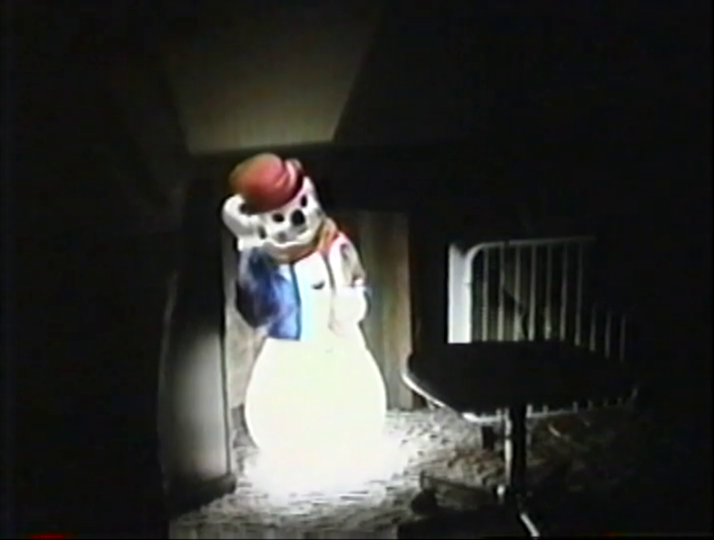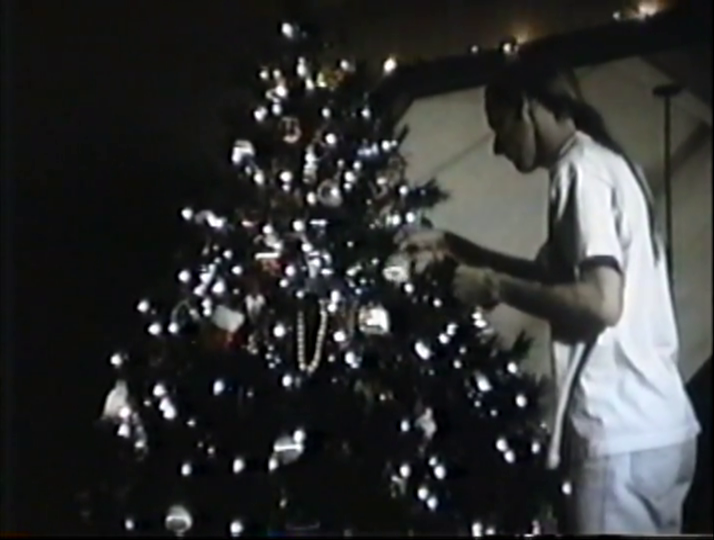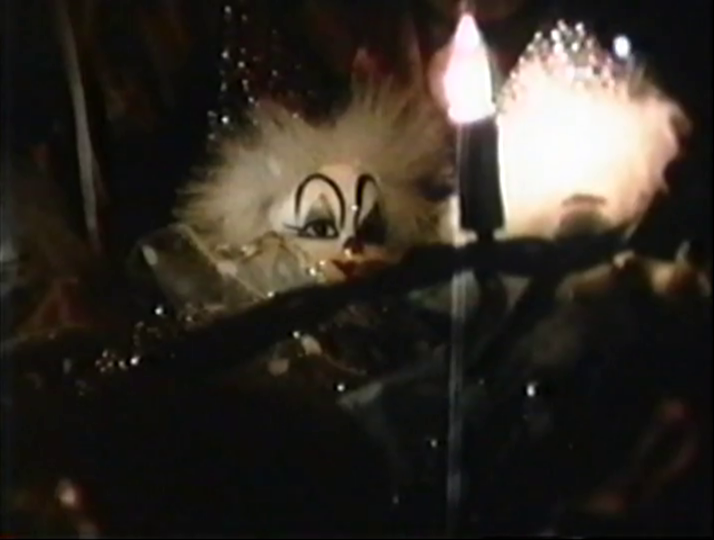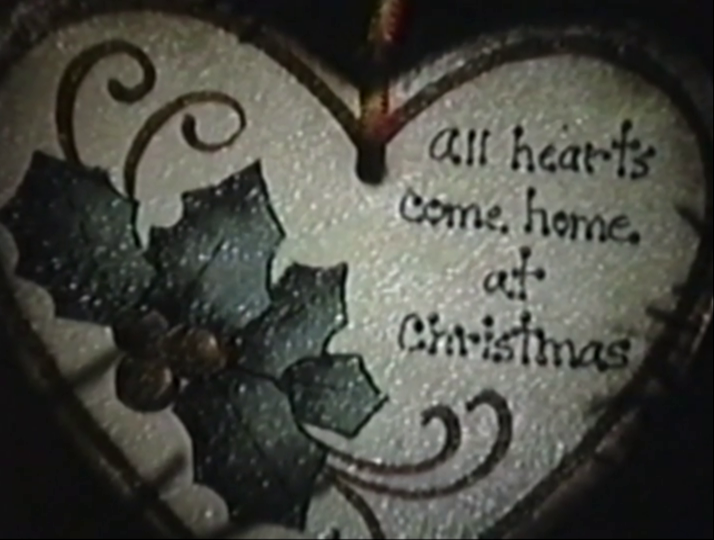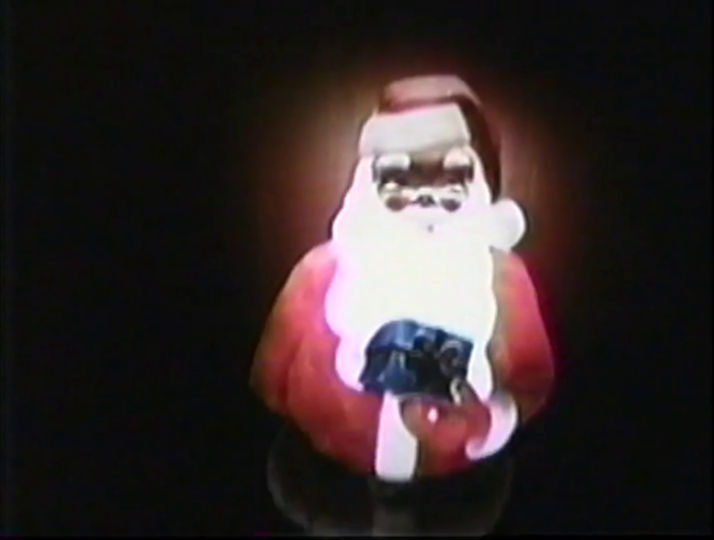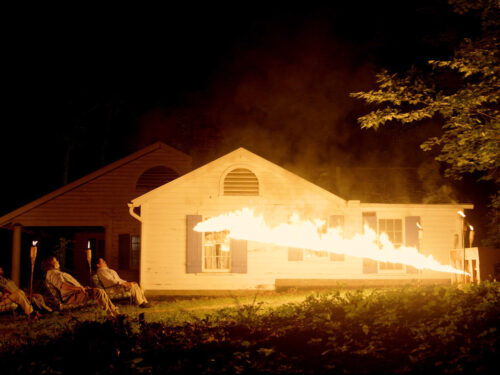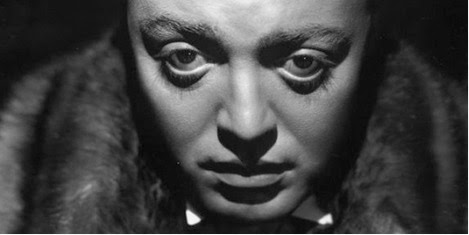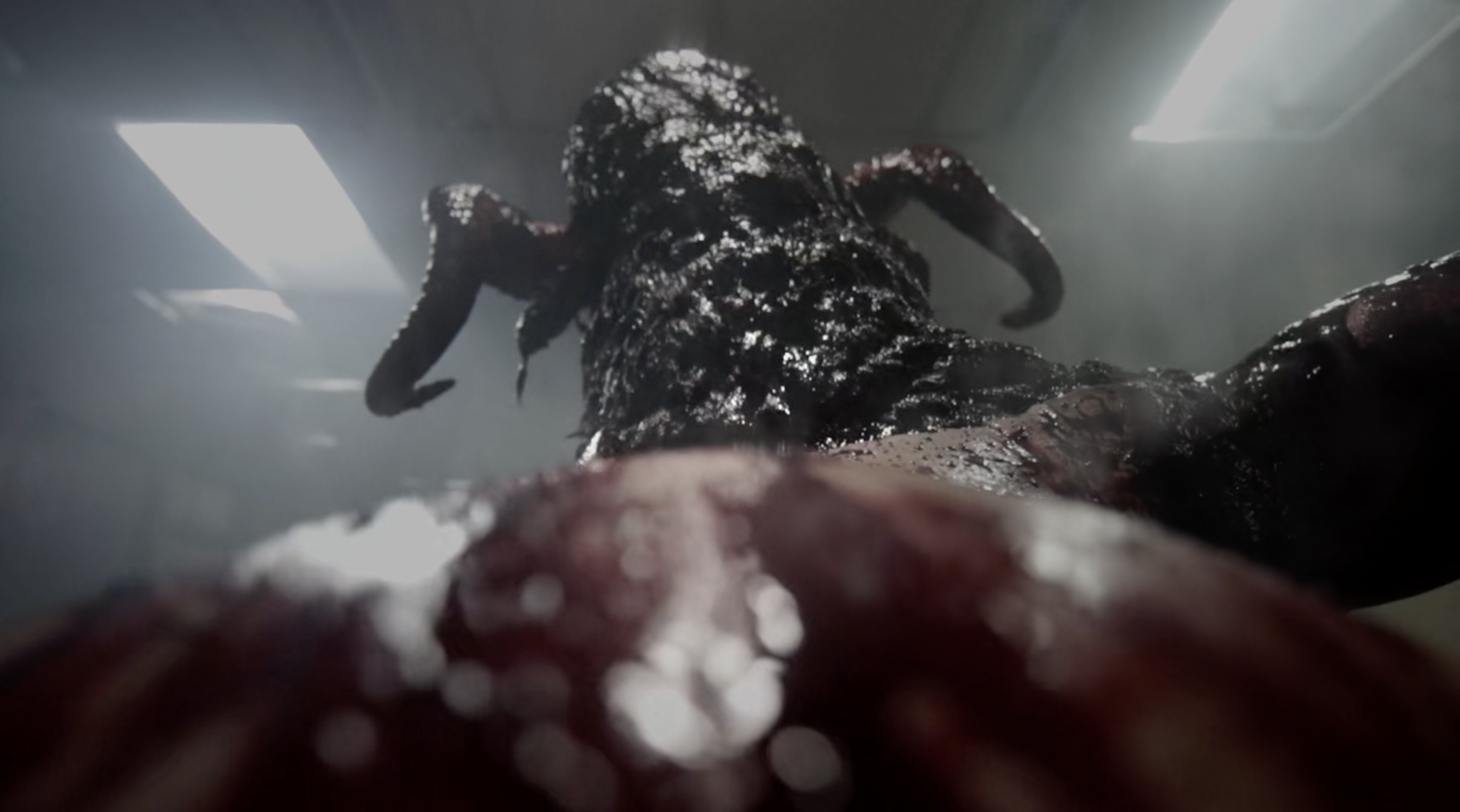In the shot-on-video holiday short “Silent Night Evil Night,” not all gifts from the heart are equally festive
The 1990s saw a drastic shift in operations in the shot-on-video (SOV) marketplace, with enterprising filmmakers taking matters of distribution and promotion into their own hands. One of the most prolific filmmakers from this direct-sale era, Todd Jason Cook carved out his own niche from his Missouri City, Texas, home. His Cemetery Cinema label debuted in 1992 (later switching names to Horrorscope Films, and Screamtime Films, which continues to this day) with the ambitious hangout slasher Evil Night1. As the decade progressed, Cook and then-wife Lisa filmed and released seven feature-length video productions, as well as five installments of the custom tape series Lisa’s Nightmares (1995-1996), and unclassifiable oddities like Lisa Cook’s Deadly Workout and Special Techniques of Low/No Budget Movies (both 1994). Cemetery/Horrorscope was also busy distributing notable works by other underground filmmakers, including Phil Herman’s Burglar from Hell (1993), Tom Vollmann’s Dead Meat (1993), and Jim Larsen’s Nigel the Psychopath (1994). By the end of the 1990s, however, Cook’s focus was solely on his own productions, and he continued churning out interesting titles even amid the late-1990s downturn of SOV horror.
His 1997 anthology, Frightmares, represents both his most distinctive and maddeningly insular work.2. His second outing in the omnibus format, after 1994’s Horrorscope, Frightmares followed the crossover success of Death Metal Zombies (1995), which had featured a large cast, several intertwining plot lines, and a soundtrack comprising artists from popular underground label Relapse Records. Cook scaled back his production style, just as he had done with 1993’s Demon Dolls. Frightmares consists of three stories, presented as individual segments without a wraparound narrative, with a total cast of three and the director himself starring in each tale. Lisa Cook is absent, save as an image on her fan website included in one story, and instead the film exists as a concentrated glimpse into the director’s own psyche as a true independent artist working on the fringes of a subcultural movement. This is Cook’s most genuinely frightening and unsettling film, a large part of which has to do with the reduction of scale on display. Here are candlelit nightmares littered with clowns, murmuring mannequins, and maximum impact wrung from inanimate objects via lighting and sound design. There’s something troubling about such small-scale stories having such effective images, and it’s an absolute testament to Cook’s skills as a filmmaker that such a quiet project manages to be so memorable. What Frightmares offers to stand out from the pack of self-distributed curios and mid-’90s anthologies is not only one of Cook’s finest overall segments, but also one of the few genuinely disturbing Christmas horror stories of the video underground.
The first story, “You or Me,” finds Jeff (Cook) stranded in a stranger’s driveway after his car breaks down late one night. After some wariness, Mark (who’s watching Death Metal Zombies) lets him in to call a friend for a ride home. Jeff insists on waiting outside, but his buddy never shows, so Mark invites him in to stay the night. After some talk, it turns out they were in some college classes together and remember each other, but that still isn’t enough to put either of their minds at ease. As they lay in bed, each man can’t shake his mistrust of the relative stranger down the hall. The last 10 minutes are back-and-forth who’s-stabbing-who nightmares, padded with some POV shots walking around Todd’s house. Cat and mouse paranoia is rendered into tedium, yet sacrifices none of the atmospheric touches of isolation.
The final story is “They’re Alive,” a one-man show starring only Cook and a house full of mannequins. Tony (Cook) sits at the computer editing a photo of Lisa for her website when a friend calls him to offer the display models. He accepts, exclaiming, “I love mannequins,” before heading out to pick them up in an old Gateway computer box. He sets them up and names them, the scene a visual parade of lifeless wooden faces. There are nice video effects as mannequin faces appear over Lisa’s image on the computer and their disembodied whispers echo throughout the house late at night. This is complimented with effective low-angle close-ups on the various mannequins’ faces set with flickering light effects. Somewhere along the way, Tony dreams of stabbing a mannequin in his bed, resting under Star Wars sheets. Investigating the various disturbances one night, his Bic lighter flicks off and the whispers moan, “You’re ours, Tony.” The final shot sees all the mannequins gathered around the dining room table with Tony’s corpse at the head.
The middle segment of Frightmares is not only its most effective piece, but also a classic and disconcerting bit of Yuletide terror. “Silent Night Evil Night,” (sic) stars only Cook (as Steve) and his father, Bill Cook, casting it as an isolationist take on holiday unhappiness and the nightmarish truths that simmer under the surface of stable family life. Paranoia is the overriding theme of the anthology, with each story proceeding from the worst-case scenarios of what can happen when one is stranded without anyone to turn to. Jeff and Mark go insane because of their inability to trust the stranger down the hall, and Tony must confront the evil of strange inanimate objects. “Silent Night” inverts this formula, investigating the horrors of our own upbringings and the question of evil within the home itself.
Steve is home alone and enjoying his freedom while his father is at work. He messes around on a dating site, microwaves a glass of milk to enjoy while watching Popeye cartoons, and blow dries his hair. He checks the mail and finds a card full of family photos he’s never seen before, as well as a letter from his sister Julie in Montana. She tells him what he’s been missing up north but provides no answers as to when she’ll return home. Bored with this routine, Steve sets to decorating the house for Christmas: he plugs in a large Santa Claus blow mold and gives it a thumbs-up, adorns various horror figures and odd puppets with Christmas lights, and dresses the tree essentially in real time. Shots of Steve hanging decorations, cutaways to his cat, and close-ups of ornaments and presents assert the seasonal festivities and dominate the screen for an extended stretch. Throughout the house, he plugs in several more blow molds, and less traditional objects like a Michael Myers mask. Dolls featured in Demon Dolls, and the full-sized clown costume from Night of the Clown (1998), are given loving attention in their new festive states. Not many SOV titles have Christmas decorating montages that capture the honest in-the-moment décor of the protagonist and creator’s home, and Cook ensures that he gets the most out of his seasonal display.
When his dad returns home from work, he’s bearing a large present for Steve and places it under the tree. He discourages Steve from shaking it and insists that it be opened last on Christmas Day. Later while out gathering firewood, Steve hears his name called from the dark. He runs inside to get his father, but they can’t find anyone on the property. That night as he sleeps, Steve has a visceral nightmare, composed of close ups on ornaments, lights, and blow molds, not to mention the dolls and ventriloquist dummies comprising their decorations. The visuals take on a hallucinatory POV quality as the camera wanders the house, moving from display to display, room to room as it considers every corner of the house and every illuminated oddity. The SVHS image gives everything a queasy orange tint — the entire experience a rancid holiday memory encased in amber rather than vibrant Christmas multicolor. We finally catch a glimpse of dad rocking a female figure with a bag over her head in a chair. The ultimate effect is that of spatial and temporal dislocation set against a festive backdrop, the menacing qualities of these decorations emerging to subvert the seasonal cheer.
Jarred from his sleep, Steve lights a candle and heads downstairs to see what’s going on. The flickering light further casts an uneasy atmosphere across the screen, rendering the electric lights scattered throughout the house as false indicators, misleading artifacts implying security but delivering no such safety. He makes his way to the tree and opens the ominous gift, finding his father waiting with a machete. The final shot reveals what was inside — a card reading “All hearts come home at Christmas,” and in the box, Julie’s heart on a card signed “Love Dad.”
On the surface, “Silent Night Evil Night” feels like a kid with a camcorder wandering the house after dark, filming his family’s decorations and himself shaking presents while his parents sleep, but the foreboding atmosphere works to assert the unknowable darkness of the season, the family secrets that stay buried beneath a façade of cheerful artificial décor. After all, many of the items in Cook’s house are not seasonally appropriate, they’re just adorned with the trappings of yuletide merriment. Every corner of the home is inhabited by a plastic figure casting its own light, mocking Steve’s ignorance and confusion. Rather than standing as visual filler, the repeated close-ups on lights and decorations become characters and atmospherics of their own design. In a film with just two performers, these plastic faces become the only reactions and impressions we receive, and their familiarity is a source of unease instead of comfort. These are things we’ve seen in countless shops or homes from our past, archetypal designs of Santa and snowmen, tempered with the objects we’ve come to expect from Cook’s own filmography. The film asserts an estrangement of the very holiday itself, for in this context we’re more familiar and at ease with the clown dolls and puppets than we are with the Christmas figures and characters themselves as well.
There’s an at-home quality throughout Cook’s filmography that makes the imagery in “Silent Night Evil Night” connect on a stronger level. Each of his films from the 1990s feature his home as the primary interior setting, with Demon Dolls and the Lisa’s Nightmares series rarely venturing beyond its confines. To those attuned to his work and familiar with the films, the effect isn’t one of invitation into a stranger’s home, but that of comfort and recognition. Cook has said as much himself, mentioning in a commentary track for Demon Dolls that his recurring use of the home is a deliberate attempt to assert his living space as an iconic and recognizable horror setting. This adds a queasy coziness to “Silent Night’s” narrative. In his resolute refusal to take his horrors into the wider world, Cook positions his holiday horror short in the very nexus of security so many of us presume at the year’s end. That all the actual violence originates from within the family unit itself, not to mention the objects that define his onscreen existence, means the final blow works more than as a neat twist.
There’s also a much larger sense of emotional desolation at play that deserves further discussion. Garish holiday lights become signposts of lives gone by, the accumulated detritus of our existence and all that remains when we ourselves become nothing but memories. Even in its brief runtime, the short engages with questions of loss and memory, from the family photos to the hand-me-down decorations, not to mention Julie’s card to her brother. Tradition itself becomes the source of a threat, one that’s bubbled beneath the surface and is always present, but only emerges at the merriest time of year.
Spending the short runtime of Frightmares, particularly the “Silent Night Evil Night” segment, largely alone with Cook proves an illuminating experience. The greatest strength of Cook’s filmmaking proves to be his commitment to insularity. With so many SOV projects you get the sense that the insularity wasn’t a choice — just a handful of kids with a camera and the only friends they could find featured on screen. But Cook’s most intriguing and singular films are built from deliberate decisions to scale things down after more expansive projects like Evil Night or Death Metal Zombies. The 1990s video underground was no stranger to skeleton casts and crews, but in creating a handful of works so thoroughly defined by social isolation, Cook cemented his status as an inveterate outsider even among his peers. Despite the success of his mail order business and the ongoing availability of his productions on tape, there’s an ever-present sense that Cook made films only for himself. By 1997, the horror video underground was in a state of flux, as direct sales and conventions proved to be the most viable option for independents. Cook never released his films through the usual distributors of the day like Alternative Cinema or EI; his was a self-directed empire of off-the-radar commerce. Because of this, “Silent Night Evil Night” hasn’t received the attention or the credit it is due for a genuinely nightmarish and bleak vision of the holiday season. It’s time that it was included in the Christmas horror canon.
For more on the history of SOV Horror, seek out Albarano’s new book, Aesthetic Deviations: Shot-On-Video Horror, 1984-1994. Purchase a copy from Headpress or Amazon
We also recommend checking out Albarano’s Experimental Kindergarten zines here
(Split Tooth may earn a commission from purchases made through affiliate links on our site.)
- Cook revised Evil Night between 1992-1994, adding more party scenes and a gratuitous sex scene with then-wife Lisa, who he met during the film’s production. Lisa would soon serve as Todd’s most frequent collaborator and muse, appearing in every feature produced through the end of the 1990s, save Frightmares.
- Night of the Clown (1998) is arguably more deliriously isolationist and tedious, but was conceived as a surreal joke rather than proper production

